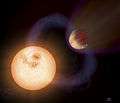SWEEPS-10
| Observation data Epoch J2000 Equinox J2000 | |
|---|---|
| Constellation | Sagittarius |
| Right ascension | 17h 59m 02.00s |
| Declination | -29° 13' 23.7"' |
| Apparent magnitude (V) | 26.23 |
| Astrometry | |
| Distance | 22,000 ly (6,600 pc) |
| Details | |
| Mass | 0.44 M☉ |
| Radius | 0.41 R☉ |
| Database references | |
| SIMBAD | data |
| Exoplanet | List of exoplanets | |
|---|---|---|
| Orbital elements | ||
| Semi-major axis | (a) | 0.008 AU |
| Orbital period | (P) | 0.424 d |
| Inclination | (i) | >84° |
| Physical characteristics | ||
| Mass | (m) | >1.6 MJ |
| Radius | (r) | 1.24±0.23 RJ |
| Discovery information | ||
| Discovery date | October 4, 2006 | |
| Discoverer(s) | Jeremy McGovern | |
| Discovery method | Transit | |
| Discovery status | Unconfirmed | |
SWEEPS-10 is an extrasolar planet that, from June 2007 to August 2011, was the planet candidate with the shortest orbital period yet found, until PSR J1719-1438 b was discovered in 2011 with an even shorter orbit. The planet orbits the star SWEEPS J175902.00−291323.7 located in the Galactic bulge at a distance of approximately 22,000 light years from Earth (based on a distance modulus of 14.1).
It completes an orbit of its star (designated SWEEPS J175902.00−291323.7) in just 10 hours, and is categorized as an ultra-short period planet (USPP). Located only 1.2 million kilometers from its star (roughly three times the distance between the Earth and the Moon), the planet is among the hottest ever detected; its estimated temperature is approximately 1,650 degrees Celsius. "This star-hugging planet must be at least 1.6 times the mass of Jupiter, otherwise the star's gravitational muscle would pull the planet apart," said team leader Kailash Sahu of the Space Telescope Science Institute in Baltimore, Maryland. Such USPPs seem to occur only around dwarf stars.
The small star's relatively low temperature allows the planet to exist. "USPPs occur preferentially around normal red dwarf stars that are smaller and cooler than our Sun," Sahu said.[1]
-

Artist's impression of an ultra-short-period planet like SWEEPS-10.
See also
- SWEEPS stands for Sagittarius Window Eclipsing Extrasolar Planet Search
- SWEEPS-04
- SWEEPS-11
References
- ↑ McGovern, Jeremy (October 4, 2006). "Hubble's SWEEPS 10". Astronomy Magazine. Retrieved 2016-02-24.
- Sahu; et al. (2006). "Transiting extrasolar planetary candidates in the Galactic bulge" (abstract). Nature. 443 (7111): 534–540. arXiv:astro-ph/0610098
 . Bibcode:2006Natur.443..534S. doi:10.1038/nature05158. PMID 17024085. (web Preprint)
. Bibcode:2006Natur.443..534S. doi:10.1038/nature05158. PMID 17024085. (web Preprint)